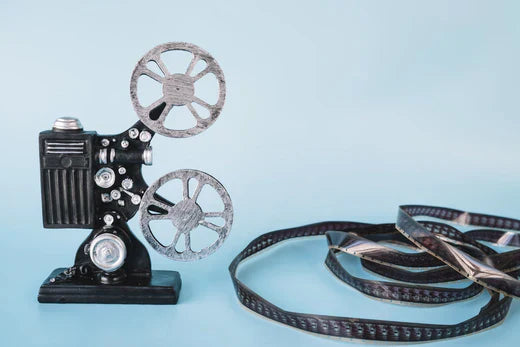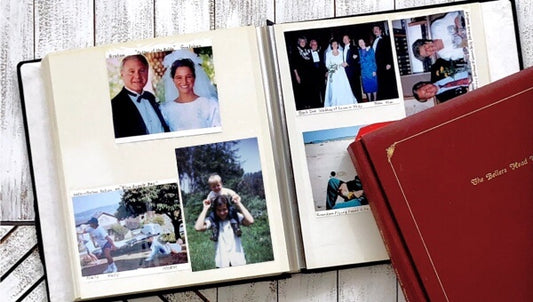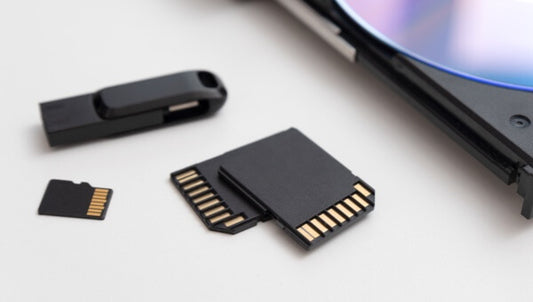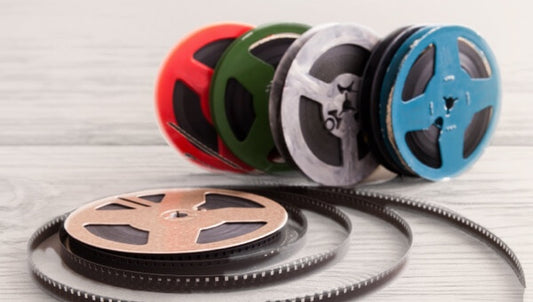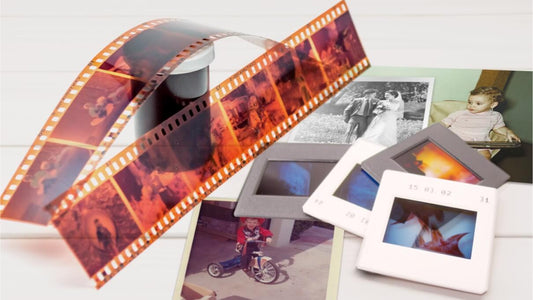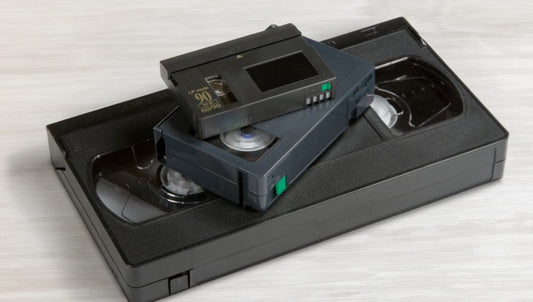Your film negatives, Polaroids, 35mm film slides, and other photo formats contain your most precious memories. Sadly, photographic film is prone to deterioration which can cause a foggy appearance, fading, staining, and other problems. Plus, if they aren’t protected from humidity, sunlight, and high temperatures, the memories could be effectively lost forever.
Over the last 20 years, our experts have learned how to preserve film the right way. While we recommend digitizing your film so future generations can enjoy it, whether you’re looking to digitize 16mm film, slides, or negatives, the guide below covers how to store film negatives, how to store developed film, and how to store negative film safely at home.
Keep reading to learn how to store unprocessed film negatives, Polaroids, 35mm transparencies, and other film types with expert tips, advice, and precautions.
Quick List of Tips for Storing Film Negatives, Polaroids, and 35mm Film
- Keep Film in a Cool Dry Place
- Use Archival Sleeves or Acid-Free Envelopes
- Store Film Flat or In a Roll
- Handle Film with Clean Dry Hands
- Protect Film from X-Rays
- Avoid Sunlight
- Label Film Properly
- Consider Using a Dehumidifier or Humidifier
- Use a Fire-Resistant Safe
- Avoid Using Tape for Organization
- Keep Film Away from Pets and Children
Tips for Storing Film Negatives, Polaroids, and 35mm Film
Negatives are the original analog format known as 1st generation because they are the first type that captures your photograph. When the unexposed film is passed through a camera and the emulsion is exposed to light, the image will appear during development.

Proper film storage protects your most precious memories from fading, moisture, and heat damage.
Because of this, negatives contain the most detail and produce the highest quality prints and digital images. Negatives can include a wide variety of film formats including 35mm, 110 format, 126 format, medium format, and large format.
In addition to negatives, you may have other film photography types like polaroids, color reversal or slide films, or black-and-white reversal films. While these may seem different than negatives, the storage and preservation tips are pretty much the same.
Here are the best tips to ensure your negative film lasts decades in good condition despite the expiration date.
Keep Film in a Cool Dry Place
Heat and humidity are the biggest enemies of film negatives and other film types. Over time, high temperatures will mute the colors, reduce vividness, and negatively impact quality. In addition, warm, humid climates can contribute to mold and mildew. However, too little humidity can also cause brittleness.
For best results:
- Maintain 25–35% relative humidity.
- Keep temperature between 35°–55°F (1°–13°C).
- Avoid attics, basements, or areas with temperature swings.
If you live in a warm climate, store film in a dark closet or cabinet away from vents or windows. For long-term film reel storage, refrigeration or cold storage can help preserve color and sharpness for decades.
Tip: When removing film from cold storage, let it warm up inside a sealed bag before opening to prevent condensation damage.
If humidity fluctuates, use a dehumidifier or humidifier to stabilize the environment. A small humidity gauge inside your film cabinet can also help ensure safe conditions year-round.
Use Archival Sleeves or Acid-Free Envelopes
Archival sleeves or acid-free envelopes are among the best ways to protect your developed film from damage. They shield against fingerprints, dust, debris, and light exposure that can gradually fade images or scratch the emulsion.
For dependable protection, choose professional-quality materials such as ClearFile Archival-Plus Print Pages or Golden State Art See-Through Sleeves. These long-lasting, acid-free options help maintain clarity and prevent deterioration even during extended storage. They also allow you to safely view your negatives and slides without removing them from their sleeves — a small but important detail that helps keep your film in pristine condition.
If you’re wondering how to store polaroid film that is already developed, you still want to keep the film cool and prevent moisture, heat, and light by keeping them in acid-free photo boxes or albums. However, make sure the rolls of film or negative strips are clean and free from dust and debris before placing them carefully into archival or acid-free storage options. We recommend using canned air to blow off any debris before storage.

Acid-free sleeves and envelopes shield film from light, dust, and fingerprints during long-term storage.
Store Film Flat or In a Roll
It is best to store negatives and other film types flat or in a roll of film because film tends to warp easily, which can distort the images, make it harder to scan them, and even crack or deteriorate the film and reduce its lifespan. You should also avoid stacking negatives because they tend to stick together, which can destroy them, especially when exposed to extreme heat.
Laying film or Polaroid photos flat can take up a lot of space, so many people use canisters to hold their color film photography. Plus, canisters mimic a darkroom to prevent overexposure to light that can cause white film and may even help to maintain low relative humidity compared with the rest of the room.
For long-term storage, consider film reel storage boxes or dedicated film storage systems that separate each roll to prevent tangling or compression. These setups also make it easier to organize and label your film by date, event, or format, reducing the need for unnecessary handling. Many families also choose to transfer 8mm film to digital once their collection is organized, ensuring every reel is safely preserved and easy to revisit without risking wear on the original film.
Handle Film with Clean Dry Hands
Film photographers recommend holding all film types including 35mm film, negatives, and Polaroids by the edges. That’s because the oil, dirt, and sweat from your hands can damage the emulsion that’s made of silver, nitric acid, and gelatin.
This can cause color negatives to lose vividness, contribute to drastic fading, cause smudges and scratches, and impact the lifespan regardless of storage conditions. In addition, touching photos also causes them to warm up, which can cause other issues.
In addition to holding film by the edges, try to only touch film with clean, dry hands. For extra protection, consider wearing lint-free cotton gloves or using anti-static gloves designed for film handling — especially before scanning or digitizing. These small steps help preserve fine detail, reduce static buildup that attracts dust, and prevent accidental damage while preparing film for long-term storage or restoration.

Always hold film by the edges or wear cotton gloves to protect the delicate emulsion surface.
Protect Film from X-Rays
While you probably don’t have an X-Ray sitting around your film camera or storage location, it’s worth mentioning that gamma radiation can destroy unprocessed film photography. When exposed to X-rays, the unprocessed film can fade, lose contrast and color, or become overexposed. Several low doses of gamma radiation can impact the film as much as one significant dose.
Because of this, you may want to avoid bringing undeveloped film on your next airplane trip because the X-Ray machines used to check your luggage could end up destroying your priceless memories forever. Whenever possible, request a hand inspection instead, especially for ISO 800 film and higher. This may slow down your passage through security, so make sure you plan ahead.
For extra protection, store film in clear, acid-free sleeves or film-safe bags that make it easy for security officers to inspect without touching. Labeling them clearly can also speed up screening and reduce the chance of mishandling. If you travel frequently with undeveloped film, consider a dedicated lead-lined film bag, which offers partial shielding against radiation and temperature changes during transit.
Avoid Sunlight
With undeveloped film as well as Polaroids or Kodak instant camera film, too much light can hurt as much as or more than high room temperatures. Light not only causes exposure issues, but it also impacts the photographic dyes.
Because of this, if you don’t have a darkroom, you should try to store all film types and negatives in drawers or boxes. However, avoid using plastic boxes because they may contain preservatives or volatile chemicals that can ruin your film. Instead, invest in an acid-free storage option as mentioned above.
Label Film Properly
You may be wondering how to store film negatives or other film types simply to protect them from damaging conditions during long-term storage, but organization is just as important. Proper labeling minimizes how often you need to handle your film, reducing exposure to light and touch while making it easier to locate specific rolls or negatives later.
Label each box, sleeve, or film canister with clear details such as the film type, date, and subject, for example, “35mm Summer Vacation 1998.” Using acid-free labels or pencil markings is safer than adhesive tape or permanent markers, which can bleed or leave residue over time.
For larger collections, consider an archival film cataloging system or digital spreadsheet that tracks formats and storage locations. This kind of simple organization not only keeps your film safer but also enhances your enjoyment when revisiting or digitizing old memories.
Consider Using a Dehumidifier or Humidifier
If you’re struggling to maintain consistent humidity, consider adding a dehumidifier or humidifier to your film storage space. In most climates, a dehumidifier is the better choice, as excess moisture encourages mold and mildew, which can permanently stain or soften film emulsion. Aim to keep humidity between 25% and 35% for optimal long-term preservation.
If you live in an especially dry environment, however, a humidifier may be necessary to prevent film from drying out and becoming brittle. For smaller collections, even silica gel packets inside storage boxes can help maintain balance without the need for larger appliances.
Use a Fire-Resistant Safe
Since your film is irreplaceable, especially if you haven’t preserved it in digital format yet, you may want to consider using a fire-resistant safe. These safes help preserve your collection in the event of a fire, flood, or other disaster.
Keep the safe in a cool, low-humidity location such as a closet or basement, and use acid-free sleeves or envelopes inside to prevent chemical reactions caused by heat or materials. This simple precaution helps ensure your memories remain safe and intact for generations.

Master how to store and preserve your film to ensure every frame remains as clear as the day it was shot.
Avoid Using Tape for Organization
Avoid using tape directly on film, negatives, or Polaroids, even on the back, since the adhesive can contain acids that degrade the surface and leave residue. Over time, this can cause staining, color shifts, or peeling that’s difficult to reverse.
Instead, label boxes, albums, or archival sleeves using a pencil or acid-free marker on a dedicated label strip. This keeps your collection organized without introducing harmful chemicals, preserving both the image and the physical integrity of your film for the long term.
Keep Film Away from Pets and Children
Keep your 35mm film, negatives, Polaroids, and all other film types stored safely out of reach of pets and children whenever possible. Curious hands or paws can easily knock over containers, shed hair, spill liquids, or leave fingerprints - all of which can damage your film or its packaging.
Store your collection in a dedicated cabinet, drawer, or shelf that’s elevated and protected from daily activity. If you’re working on organizing or digitizing film at home, set up a clean workspace away from food and moisture. A few simple precautions can help ensure your film remains safe and undisturbed, preserving your irreplaceable memories for decades to come.
From Safe Storage to Timeless Digital Preservation
Knowing how to store film properly is important to preserving the physical copies containing a lifetime of memories. The most important lessons for how to store 35mm film, negatives, and Polaroids are to maintain a low humidity (but not too low), protect film from light and heat, and keep them in acid-free storage options away from damaging fingers, dust, and debris.
However, the best way to permanently store film and make sure that future generations can enjoy, view, share, and love your memories is to digitize film with Capture. We can create high-quality digital copies of your film while keeping your original negatives and film types safe from harm.



